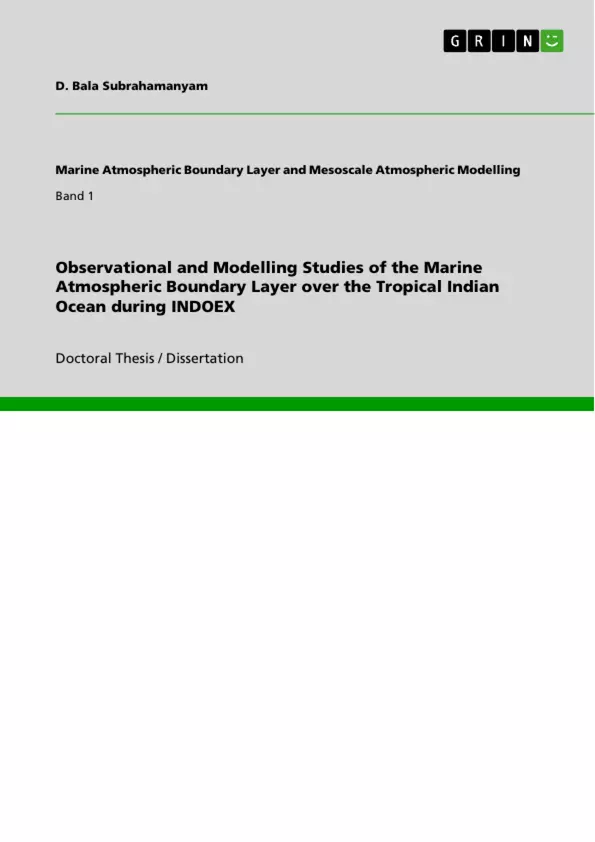The Atmospheric Boundary Layer (ABL) over the oceanic surface is commonly referred to as the Marine Atmospheric Boundary Layer (MABL) and it can be considered as the turbulent region in the immediate vicinity of the oceanic surface. The major features that distinguish the ABL over ocean from its land counterpart are the wet, mobile, lower boundary in addition to certain ocean-specific thermodynamic and dynamic characteristics. The structure and characteristics of the MABL and its interactions with the oceanic surface and the overlying free atmosphere are known mainly as a result of a synergistic combination of observational studies, numerical and laboratory simulations, and dimensional analysis. Our present knowledge and understanding of the MABL over various oceanic regions of the globe comes from the experience and expertise acquired during various field experiments. The present thesis aims at improving our understanding of the structural characteristics of the MABL and its associated dynamics over the data-sparse region of western tropical Indian Ocean by making use of the meteorological data collected onboard Oceanic Research Vessel (ORV) Sagar Kanya and Kaashidhoo Climate Observatory (KCO) during the Intensive Field Phase (IFP-99) of the Indian Ocean Experiment (INDOEX).
Inhaltsverzeichnis (Table of Contents)
- Introduction
- Literature Review
- Marine Atmospheric Boundary Layer
- Tropical Indian Ocean
- INDOEX Experiment
- Experimental Setup and Observations
- The Indian Ocean Experiment (INDOEX)
- The MABL Experiments onboard ORV Sagar Kanya
- Data Acquisition and Processing
- Results and Discussions
- MABL Structure and Evolution
- MABL Dynamics
- Energy Budget and Turbulent Fluxes
- Cloud Microphysics and Aerosol Properties
- Modelling Studies
- The MM5 Model
- Model Simulations and Comparisons with Observations
- Conclusions
Zielsetzung und Themenschwerpunkte (Objectives and Key Themes)
This thesis investigates the structure, dynamics, and energy budget of the marine atmospheric boundary layer (MABL) over the tropical Indian Ocean during the Indian Ocean Experiment (INDOEX). The study utilizes observational data collected from the MABL experiments conducted onboard the Oceanic Research Vessel (ORV) Sagar Kanya. The research aims to understand the influence of different atmospheric processes on the MABL characteristics and its role in the global climate system.
- Characteristics and evolution of the marine atmospheric boundary layer (MABL) over the tropical Indian Ocean
- Dynamics of the MABL, including turbulent fluxes and energy budget
- Impact of cloud microphysics and aerosol properties on the MABL
- Modeling studies of the MABL using the MM5 model
- Comparison of model simulations with observational data
Zusammenfassung der Kapitel (Chapter Summaries)
The introductory chapter provides an overview of the marine atmospheric boundary layer (MABL), its importance in the global climate system, and the role of the tropical Indian Ocean. It also presents the context of the Indian Ocean Experiment (INDOEX) and the objectives of the thesis.
The second chapter reviews previous studies related to the MABL, the tropical Indian Ocean, and the INDOEX experiment. This chapter provides a foundation for the research presented in the thesis and highlights the gaps in existing knowledge that the research aims to address.
The third chapter describes the experimental setup and observations used in the study. This includes details of the INDOEX campaign, the MABL experiments conducted onboard ORV Sagar Kanya, and the data acquisition and processing techniques.
Chapter 4 presents the results of the analysis of the MABL structure and evolution, including the diurnal variations, the influence of different atmospheric processes, and the role of clouds and aerosols. This chapter analyzes the dynamic aspects of the MABL, including turbulent fluxes and energy budget.
Chapter 5 focuses on the modeling studies using the MM5 model. This chapter describes the model setup, the simulation results, and the comparison of the model simulations with the observational data. The analysis of the model output provides further insights into the MABL characteristics and its response to different forcing mechanisms.
Schlüsselwörter (Keywords)
The research focuses on the marine atmospheric boundary layer (MABL), the tropical Indian Ocean, the Indian Ocean Experiment (INDOEX), cloud microphysics, aerosol properties, turbulence, energy budget, and numerical modeling.
- Arbeit zitieren
- Dr. D. Bala Subrahamanyam (Autor:in), 2003, Observational and Modelling Studies of the Marine Atmospheric Boundary Layer over the Tropical Indian Ocean during INDOEX, München, GRIN Verlag, https://www.hausarbeiten.de/document/177160


